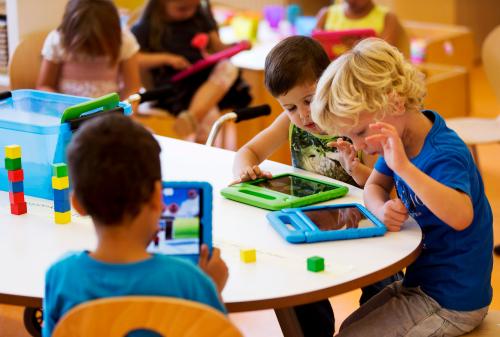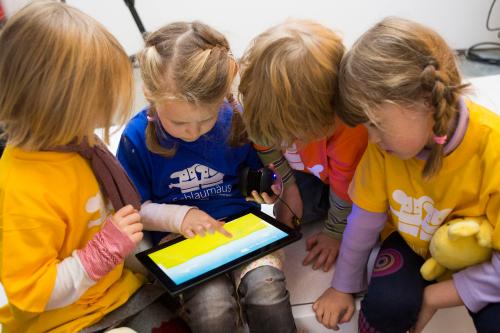This post originally appeared on the Stanford Social Innovation Review (SSIR) as part of the Preparing Today’s Youth for Tomorrow’s World series produced in partnership with SSIR and CUE.
Earlier this year, we visited developers from IBM Watson, famous for creating the intelligent machine that beat both the world’s top chess player and the long-time Jeopardy! champion. IBM’s work to simulate the intelligence and actions of humans has reached the level of science fiction, prompting the question: What will the world look like in the future? Depending on which economist you talk to, advances in technology such as AI either hold incredible promise—enabling increases in productivity that will give us twice as much leisure time—or mark the end of decent work for most of the population and an incredible increase in inequality.
Skills that allow young people to adapt to rapid change could be an important factor in determining whether the future is full of promise or peril. Automation has hollowed out the labor market, leaving many middle-skilled workers out of work or in low-wage jobs, a phenomenon documented in more than 30 countries across the developed and developing world. On the other hand, the skills that are uniquely human and that complement digital technologies are increasingly in demand. These skills, such as communication, teamwork, critical thinking, and flexibility, have always been important for work and life, but the current context makes them even more crucial for future generations. A 70-country study by the McKinsey Global Institute estimates that by 2020, approximately 83 million high- and middle-skilled jobs will go unfilled because employers looking to hire in developed and developing countries will not find people with the necessary skills.
Not only individuals’ future employment needs, but also ever-more-complex global challenges demand a new approach to education. As boundaries between nations and communities that once contained our problems fade, we will need creative solutions to problems such as climate change, the global migrant crisis, and, as the spread of the Zika virus reminds us, cross-border health epidemics. We need to foster good global citizens who actively care about their communities and the world, work together to solve problems across boundaries, and contribute to more inclusive and peaceful societies.
Throughout history, every society has grappled with how to best educate and prepare its young people for the world they will face. From hunter-gatherers thousands of years ago who had to impart vast amounts of knowledge about plants, animals, and relations between tribes to their youth, to craftsmen who taught trades through apprenticeships that defined education for many young men in the 18th and 19th centuries, humans have adapted education to meet the needs and challenges of the time.
Our current world and the changes we predict for the future call for education to equip every young person with the appropriate set of skills. Academic skills—such as mastery of reading, math, and science—are crucial but not sufficient. Young people increasingly need to be able to do such things as develop ideas, empathize with others, and collaboratively problem-solve; they also need to have the resilience and adaptability to continue to learn and master new things. Indeed, some learning scientists argue that these non-academic skills are among the most important skills of all, as they can help to both drive better academic outcomes in school and prepare children to thrive in a changing world.
The problem is that most children are not participating in the learning experiences that would help them develop this full breadth of skills. Opportunities to engage in the types of experiences in and out of school that do promote these skills are too often unequally distributed between richer and poorer children, perpetuating deep inequities both between and within nations.
We know more about young people’s academic competence, including their ability to think critically and analytically, than their non-academic skills, due to regular international student assessments in subjects such as math, reading, and science. The United States, which regularly beats itself up about the quality of its education system, actually has some of the best schools in the world, but stark inequities hold it back. Students in the state of Massachusetts, for example, achieve scores equivalent to the top 10 high-income countries in the world, demonstrating strong problem-solving and critical thinking skills in math. However, scores of students in Mississippi are tied with Chile for second-to-last place on the same list, beating out only Mexico.
Most students in low- and middle-income countries, those where per-capita income is less than $12,475 per year, perform far worse in academic competence than even the least accomplished students in the United States. By one estimate of reading and math skills, an average student in these countries scores alongside the worst 8 percent of students in countries where the annual per-capita income is above $12,475. And that only considers the students who are in school and being tested—not the 120 million kids shut out of academic learning all together, of which more than 96 percent live in developing countries. Based on a number of measures of academic learning and school completion, we have found that at the current pace of change, it would take nearly 100 years to close the education gap between rich and poor countries.
We know much less about children’s non-academic skills, largely because they are not easily captured in international student assessments. However, we do know that many educators, employers, and academics are deeply worried that children’s learning experiences often do not enable them to develop the full breadth of skills they need. For example, employers around the world regularly express unhappiness with young people’s lack of “workplace competencies”like communication and teamwork. The foundation for these and other skills, such as creativity and learning agility, are laid in early childhood, and we know that globally a full 200 million children below the age of 5 are not achieving proper cognitive development due to impoverished early childhood experiences that include poor nutrition and lack of stimulation. We also know that children from high-income families struggle to master the full range of skills necessary, even if they perform well on academic measures, often because parents and schools do not provide learning experiences that would cultivate skills and attitudes such as the ability to work hard to meet goals and resilience in the face of failure.
Ultimately, we need to redefine the basics to include the full breadth of academic and non-academic skills that all children, rich and poor alike, need. Then we need to rethink how to help children have the types of learning experiences—both in and outside of school—that can help cultivate these skills.
That’s why we are excited to announce this series, Preparing Today’s Youth for Tomorrow’s World. Over the next 10 months, experts from around the globe will weigh in on some of the biggest challenges that we face today in achieving breadth of skills that the world’s children will need, and give examples of success in widely varying contexts. Contributors will include many of our scholars from the Center for Universal Education at the Brookings Institution, as well as a diverse array of individuals implementing programs on the ground.
The series will examine critical areas where education efforts from early childhood through adolescence, in and outside of classrooms, can give children the skills they need to deal with rapid change and how our current systems can adapt to cultivate this broader vision of learning; how innovative solutions can be implemented and scaled; and perhaps most importantly, how to reach the world’s most marginalized children. Our aim is to bring together the latest evidence and a diversity of perspectives to increase understanding of and debate on one of the most burning issues of our time. We encourage you to follow along and participate in the conversation here at Stanford Social Innovation Review and on social media.






Commentary
Rethinking education in a changing world
September 12, 2016